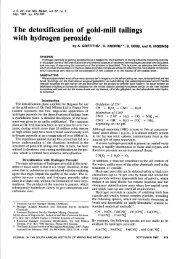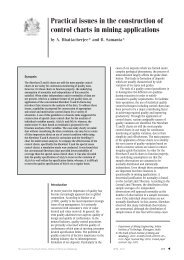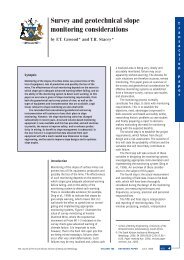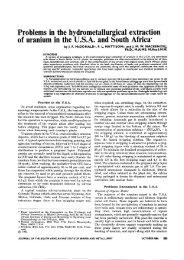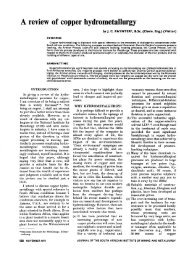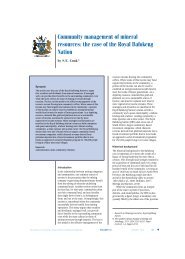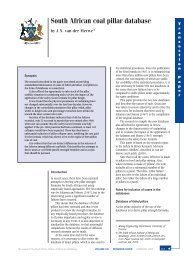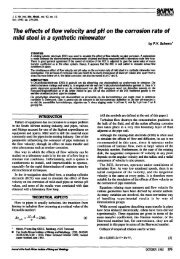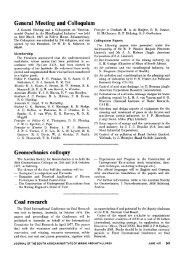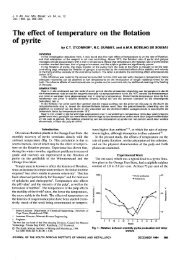The intensive cyanidation of gold-plant gravity concentrates - saimm
The intensive cyanidation of gold-plant gravity concentrates - saimm
The intensive cyanidation of gold-plant gravity concentrates - saimm
You also want an ePaper? Increase the reach of your titles
YUMPU automatically turns print PDFs into web optimized ePapers that Google loves.
Introduction<br />
When mining operations first commenced on the<br />
Witwatersrand, the method <strong>of</strong> extracting <strong>gold</strong> from the<br />
ore was by stamp-milling and amalgamationl. With the<br />
introduction <strong>of</strong> <strong>cyanidation</strong> in 1890, the amalgamation<br />
<strong>of</strong> stamp-mill pulp was still retained so that as much <strong>gold</strong><br />
as possible could be recovered at an early stage. With<br />
the later development <strong>of</strong> the closed <strong>gravity</strong> circuit,<br />
classified <strong>concentrates</strong> were again treated by amalgamation,<br />
and this practice is in use at the present time. <strong>The</strong><br />
process involves the batch treatment <strong>of</strong> high-grade<br />
riffie- belt <strong>concentrates</strong> with mercury in amalgamation<br />
barrels. <strong>The</strong> barrel is rotated for a period ranging between<br />
14 and 18 hours in order to liberate and polish the<br />
<strong>gold</strong> particles. Suitable quantities <strong>of</strong> lime, caustic soda,<br />
cyanide, and detergent are usually added to assist in this<br />
cleaning and polishing <strong>of</strong> the free <strong>gold</strong>. An adequate<br />
amount <strong>of</strong> mercury is then added to the barrel, and the<br />
rotation is continued for several hours during which time<br />
the mercury and <strong>gold</strong> form a s<strong>of</strong>t amalgam. After amalgamation,<br />
the barrel is emptied over a single amalgam<br />
plate and the s<strong>of</strong>t amalgam is then scraped by hand from<br />
the plate surface. Alternatively, the barrel contents are<br />
discharged through a hydrocyclone, and the amalgam is<br />
recovered from the spigot discharge. After being cleaned,<br />
the amalgam is filtered and retorted. <strong>The</strong> retorting <strong>of</strong><br />
the pressed amalgam is carried out in an electric furnace<br />
at approximately 600°C, the condensed mercury being<br />
collected in buckets and recycled, while the sponge <strong>gold</strong><br />
is smelted and cast into bars. Mercury losses during<br />
retorting should not normally exceed 0,02 g per ton <strong>of</strong> ore<br />
milled. <strong>The</strong> recovery <strong>of</strong> <strong>gold</strong> from <strong>gravity</strong> <strong>concentrates</strong><br />
using amalgamation is about 96 to 97 per cent, although<br />
the overall recovery may be even higher because the<br />
amalgam tailings are returned to the head <strong>of</strong> the <strong>gravity</strong><br />
circuit. <strong>The</strong> process may involve a considerable health<br />
hazard related to mercury ingestion, and is at the same<br />
time very labour-<strong>intensive</strong>.<br />
As a result <strong>of</strong> earlier improvements to the recovery <strong>of</strong><br />
<strong>gold</strong> in the <strong>gravity</strong> sections <strong>of</strong> existing <strong>gold</strong> <strong>plant</strong>s2 and<br />
the consequent need to treat larger tonnages <strong>of</strong> <strong>concentrates</strong>,<br />
an alternative processing route for <strong>gold</strong>-<strong>plant</strong><br />
<strong>gravity</strong> <strong>concentrates</strong> was indicated. Concern about the<br />
pollution and health aspects <strong>of</strong> the amalgamation process<br />
was further motivation in the development <strong>of</strong> an alternative<br />
procedure. <strong>The</strong> advantages sought from such a route<br />
included low-risk working conditions, together with the<br />
elimination <strong>of</strong> the large recycling load <strong>of</strong> <strong>concentrates</strong><br />
in the <strong>gold</strong>-<strong>plant</strong> <strong>gravity</strong> circuit and perhaps a less<br />
labour-<strong>intensive</strong> operation. A <strong>gold</strong> recovery equal to or<br />
better than the amalgamation route was also a prime<br />
requirement <strong>of</strong> such an alternative process. Earlier<br />
work carried out in these laboratories on the recovery <strong>of</strong><br />
<strong>gold</strong> from both belt-concentrator tailings and amalgamation<br />
tailings had indicated that the <strong>cyanidation</strong> or<br />
high-grade <strong>gravity</strong> <strong>concentrates</strong> merited further investigation.<br />
In view <strong>of</strong> the varied and relatively long history<br />
<strong>of</strong> the <strong>gold</strong>-mining industry in South Africa, it may have<br />
been expected that the <strong>cyanidation</strong> <strong>of</strong> high-grade <strong>concentrates</strong><br />
was well documented in the literature. However,<br />
a literature survey carried out in early 1974 failed<br />
to indicated any relevant information in this respect. <strong>The</strong><br />
only useful information was derived from numerous<br />
publications dealing with investigations on the dissolut,ion<br />
<strong>of</strong> pure <strong>gold</strong>, but the extent to which such data could<br />
be applied to <strong>gold</strong> <strong>concentrates</strong> had yet to be established.<br />
Concurrently with the literature survey, work started on<br />
the on-site sampling <strong>of</strong> <strong>gold</strong>-<strong>plant</strong> belt <strong>concentrates</strong> and<br />
preliminary <strong>cyanidation</strong> tests.<br />
<strong>The</strong> preliminary <strong>cyanidation</strong> testwork, which was<br />
carried out in stirred beakers, was most significant in<br />
that a very wide range <strong>of</strong> <strong>gold</strong> extractions, indicating<br />
very poor reproducibility, was obtained. This poor<br />
reproducibility suggested that some hitherto unforeseen<br />
experimental variable (or variables) was playing a critical<br />
role in the <strong>gold</strong> dissolution. Further investigations<br />
directed towards a better understanding <strong>of</strong> such reaction<br />
parameters were thus most necessary.<br />
Composition <strong>of</strong> Belt Concentrates<br />
Weekly composite samples <strong>of</strong> belt <strong>concentrates</strong> from<br />
Welkom Gold Mine, designated Wl to W6, were washed<br />
in acetone and dried at 110°C prior to blending and<br />
splitting. <strong>The</strong> detailed analysis <strong>of</strong> four <strong>of</strong> these samples<br />
is presented in Table I, from which it can be seen that<br />
the <strong>gold</strong> content varied from 6 to 22 kgft, reflecting the<br />
extreme difficulty in obtaining representative samples <strong>of</strong><br />
such high-grade materials.<br />
<strong>The</strong> average UaOs content can be seen to be approxiSl<br />
mately 23 kgft, while the average platinum content <strong>of</strong><br />
44 gft indicates a value for the total platinum-group<br />
metals (PGM) according to Cousins3 <strong>of</strong> approximately<br />
277 gft. <strong>The</strong> presence <strong>of</strong> such high concentrations <strong>of</strong><br />
uranium and PGM was indicative <strong>of</strong> the recycling <strong>of</strong> a<br />
high percentage <strong>of</strong> material in the <strong>gold</strong>-<strong>plant</strong> <strong>gravity</strong><br />
circuit. <strong>The</strong> relatively large amounts <strong>of</strong> metallic tramp<br />
iron present (19 per cent) should be noted, because such<br />
material, if not effectively passivated, will precipitate<br />
the <strong>gold</strong> from the cyanide solution. <strong>The</strong> presence <strong>of</strong><br />
copper (0,46 per cent), nickel (0,13 per cent), cobalt (0,10<br />
per cent), and arsenic (0,29 per cent) should also be<br />
noted as possible major cyanide-consuming elements.<br />
<strong>The</strong> samples studied had a very similar composition<br />
with regard to their pyrite (35 per cent) and silica (33<br />
per cent) contents.<br />
Table II presents the screen analysis <strong>of</strong> samples<br />
Wl to W4, showing that, on average, 7,2 per cent by mass<br />
<strong>of</strong> the material is coarser than 295 /Lm while containing<br />
only 4,4 per cent <strong>of</strong> the total <strong>gold</strong>. On average, 6,1 per<br />
cent <strong>of</strong> the material is below 43 /Lm, but it contains as<br />
much as 26,1 per cent <strong>of</strong> the total <strong>gold</strong> content. Furthermore,<br />
on average 85 per cent <strong>of</strong> the particulate <strong>gold</strong><br />
present is smaller than 147 fl-m.<br />
Because <strong>of</strong> the presence <strong>of</strong> considerable concentrations<br />
<strong>of</strong> PGM in such <strong>concentrates</strong>, the analyses for residual<br />
<strong>gold</strong>, silver, and platinum were carried out by acid<br />
digestion <strong>of</strong> the samples followed by atomic-absorption<br />
analysis.<br />
Cyanidation <strong>of</strong> Gravity Concentrates<br />
Consumption <strong>of</strong> Cyanide<br />
Because <strong>of</strong> the excessive cyanide consumptions ob.<br />
served in the treatment <strong>of</strong> <strong>gravity</strong> <strong>concentrates</strong>, the<br />
JOURNAL OF THE SOUTH AFRICAN INSTITUTE OF MINING AND METALLURGY JANUARY 1978 147




